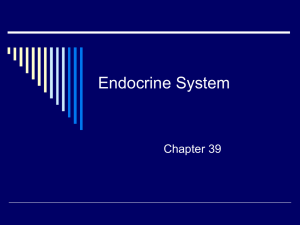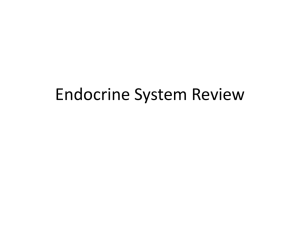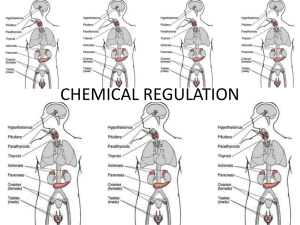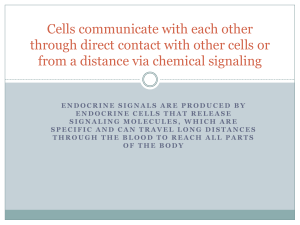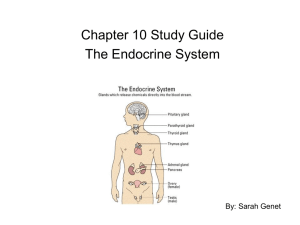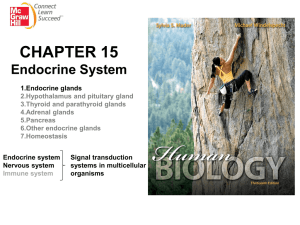Answers to Mastering Concepts Questions
advertisement
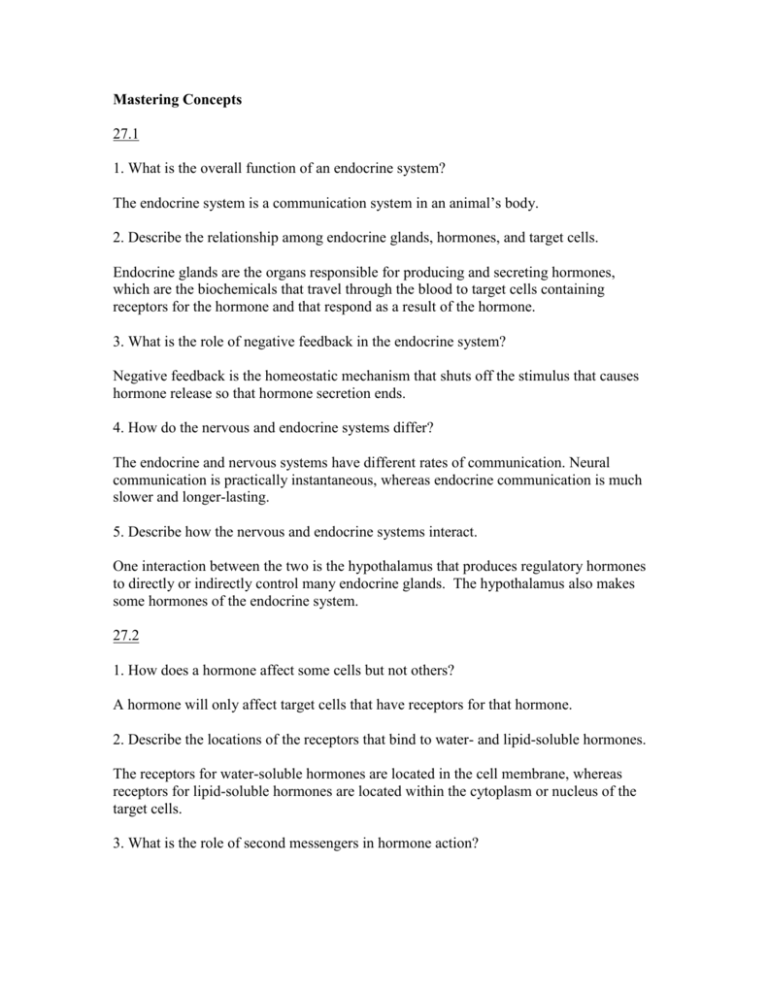
Mastering Concepts 27.1 1. What is the overall function of an endocrine system? The endocrine system is a communication system in an animal’s body. 2. Describe the relationship among endocrine glands, hormones, and target cells. Endocrine glands are the organs responsible for producing and secreting hormones, which are the biochemicals that travel through the blood to target cells containing receptors for the hormone and that respond as a result of the hormone. 3. What is the role of negative feedback in the endocrine system? Negative feedback is the homeostatic mechanism that shuts off the stimulus that causes hormone release so that hormone secretion ends. 4. How do the nervous and endocrine systems differ? The endocrine and nervous systems have different rates of communication. Neural communication is practically instantaneous, whereas endocrine communication is much slower and longer-lasting. 5. Describe how the nervous and endocrine systems interact. One interaction between the two is the hypothalamus that produces regulatory hormones to directly or indirectly control many endocrine glands. The hypothalamus also makes some hormones of the endocrine system. 27.2 1. How does a hormone affect some cells but not others? A hormone will only affect target cells that have receptors for that hormone. 2. Describe the locations of the receptors that bind to water- and lipid-soluble hormones. The receptors for water-soluble hormones are located in the cell membrane, whereas receptors for lipid-soluble hormones are located within the cytoplasm or nucleus of the target cells. 3. What is the role of second messengers in hormone action? The role of second messengers is to act within the cell to activate the enzymes that produce the hormone’s effects. 4. Explain the observation that peptide hormones usually act faster than steroid hormones. Peptide hormones usually act faster than steroid hormones because they activate chemical cascades within the cell. In contrast, steroid hormones cross cell membranes and may enter the nucleus and bind to a receptor on DNA. This will trigger the production of proteins, which takes a few minutes. Or the steroid may bind to a receptor in the cytoplasm and the combination travels to the nucleus to interact with DNA. Either process takes more time than just triggering the activation of chemicals that are present within the cytoplasm. 27.3 1. How does the hypothalamus interact with the posterior and anterior pituitary glands? The hypothalamus controls secretions from the pituitary gland. Releasing hormones from the hypothalamus stimulate the secretion of pituitary hormones, and inhibiting hormones from the hypothalamus inhibit the secretion of anterior pituitary hormones. In addition, the hypothalamus secretes hormones that are then stored in the posterior pituitary. 2. List the names and functions of the hormones released by the posterior and anterior pituitary glands. The posterior pituitary releases oxytocin, which stimulates smooth muscle contraction in the uterus and mammary glands. The posterior pituitary also releases ADH, which promotes water conservation in the kidney. The anterior pituitary secretes GH to stimulate tissue growth, prolactin to stimulate milk production, TSH to stimulate the release of thyroid hormones, ACTH to stimulate the release of glucocorticoid hormones from the adrenal cortex, FSH and LH to stimulate sex cell production and sex hormone release, and peptides to act on pain relief at receptors in the brain. 27.4 1. What are the three hormones produced in the thyroid, and what are their functions? Thyroid hormones include: - thyroxine: increases the rate of metabolism in cells; - triiodothyronine: increases the rate of metabolism in cells; - calcitonin: increases the rate at which calcium is deposited in bone. 2. What is the function of parathyroid hormone (PTH)? PTH increases calcium levels in blood and tissue fluid by increasing calcium release from bones and by increasing calcium absorption into the blood from the digestive tract and kidneys. 3. How do the functions of hormones secreted by the adrenal cortex and adrenal medulla differ? Hormones secreted by the adrenal cortex (glucocorticoids and mineralocorticoids) suppress the immune system, are important in the body’s response to prolonged stress, and maintain blood volume and salt balance. Hormones secreted by the adrenal medulla (epinephrine and norepinephrine) are important in the body’s response to short-term stress. They increase the heart rate, breathing rate, blood flow, and blood glucose and shunt blood toward the brain and muscles. 4. Describe the opposing roles of insulin and glucagon. Both insulin and glucagon affect the level of glucose in the blood, but they have opposite effects. Insulin removes glucose from the bloodstream by stimulating cells to absorb it. Glucagon stimulates liver cells to release glucose into the bloodstream. 5. How do darkness and light affect melatonin secretion? Darkness stimulates melatonin production, whereas light inhibits melatonin synthesis in the pineal gland. 27.5 1. Which organs contain target cells for FSH and LH? The testes and the ovaries contain receptors for FSH and LH. 2. What are the functions of estrogen, progesterone, and testosterone? Estrogen promotes the development of female secondary sex characteristics and inhibits secretion of GnRH from the hypothalamus. Progesterone maintains a pregnancy. It also inhibits secretion of GnRH from the hypothalamus, which inhibits the production of LH and FSH. Testosterone produces male secondary sex characteristics and inhibits the production of LH and FSH. 27.6 1. Summarize the evidence for an evolutionary relationship between fish gills and a chicken’s parathyroid glands. First is the location of the parathyroid gland, which is similar to the location of gills in fish. Second, both gills and the parathyroid gland originate from an embryonic structure known as a pharyngeal gill slit. Third, the same gene, Gcm-2, is required for gill development in the Danio and parathyroid development in mice. 2. How do you think the embryos in figure 27.16 would look if the probe indicated expression of a gene required for cellular respiration? Since cellular respiration is necessary for every cell to produce ATP, the entire embryo would be dark blue. Write It Out 1. How does the endocrine system interact with the nervous system? The circulatory system? The nervous and endocrine systems are tightly integrated. For example, some chemicals can act as both neurotransmitters and hormones. Some neurons in the hypothalamus, a brain structure that links the nervous and endocrine systems, release hormones. In addition, neurotransmitters and hormones share some target cells. The endocrine system interacts with the circulatory system by releasing hormones into the bloodstream. 2. A queen honeybee secretes a substance from a gland in her mouthparts that inhibits the development of ovaries in worker bees. Is this substance most likely a hormone, a neurotransmitter, or a pheromone? Cite a reason for your answer. The chemical would most likely be a pheromone, which is a communication molecule that transmits signals to other individuals. Hormones and prostaglandins are communication molecules that act within the body of a single organism. 3. What prevents a hormone from affecting all body cells equally? A hormone exerts a physiological effect only on target cells that have specific receptors for the hormone. 4. Many dairy operators inject their cows with bovine growth hormone to stimulate milk production. Cite two reasons that bovine growth hormone might not stimulate growth in people drinking the milk. Bovine growth hormone would probably not interact with receptors on target cells in humans, because bovine growth hormone probably has a slightly different shape than human growth hormone. In addition, bovine growth hormone in milk could be destroyed in a person’s digestive system and never enter the bloodstream. 5. How do hormones regulate their own levels? Negative feedback loops ensure that the levels of a hormone in the bloodstream are not too high or too low. In a positive feedback loop, the presence of a hormone increases its production. 6. Compare and contrast the endocrine and nervous systems. The nervous and endocrine systems both interact to maintain homeostasis, and both rely on chemicals for communication (i.e. neurotransmitters and hormones). The nervous system acts faster and more locally than the endocrine system. 7. Sketch the mechanisms of peptide and steroid hormone function. [Answer will be visual. Refer to figure 27.4.] 8. List the hormones released from the posterior pituitary and the anterior pituitary. The posterior pituitary releases antidiuretic hormone (ADH) and oxytocin. The anterior pituitary gland releases growth hormone, prolactin, follicle-stimulating hormone (FSH), luteinizing hormone (LH), thyroid-stimulating hormone (TSH), and adrenocorticotropic hormone. 9. How are the pituitary and adrenal glands each really two glands in one? The pituitary gland has both an anterior and posterior portion, each with different functions and made of different types of tissue. The adrenal gland has a medulla that secretes different hormones from the adrenal cortex. 10. Which hormone(s) match each of the following descriptions? a. Produced by a woman who is breast feeding b. Causes fatigue if too little is present c. Causes increase in blood calcium level d. Causes decrease in blood glucose level e. Synthetic steroid drugs mimic the muscle-building effects of this hormone. (a) Prolactin. (b) Insulin and thyroxine (metabolism is affected). (c) Parathyroid hormone (PTH). (d) Insulin. (e) Testosterone. 11. Describe how thyroxine, triiodothyronine, TSH, and TRH interact. When levels of thyroxine and triiodothyronine are low, the hypothalamus releases TRH, which stimulates cells in the anterior pituitary gland to secrete TSH. TSH travels in the bloodstream and stimulates cells in the thyroid gland to produce and secrete thyroxine and triiodothyronine. 12. Ancient Egyptian doctors treated goiters with seaweed, not realizing that it was the iodine in the seaweed that was reversing the condition. Why would iodine help cure a goiter? Iodine is needed by the thyroid to produce the thyroid hormones. Low iodine is the cause of the swollen thyroid gland. 13. Why would a physician counsel a patient with high blood pressure to try to reduce the amount of stress in his or her life? In response to stress, the adrenal medulla releases epinephrine and norepinephrine, both of which elevate blood pressure and heart rate. Also, the adrenal cortex releases glucocorticoids in response to long-term stress. Glucocorticoids, such as cortisol, constrict blood vessels, increasing blood pressure. 14. Sleep deprivation increases cortisol concentrations in the blood. Why would sleep deprivation be associated with increased risk of illness? Secretion of the steroid hormone cortisol leads to a depression of the immune system. 15. Search the Internet for a diabetes risk test. What actions can you take to reduce your risk of type 2 diabetes? The two main actions you can take to prevent type II diabetes are eating healthy and increasing exercise. 16. How might insulin-producing stem cells transplanted to the pancreas help people with type 1 diabetes? Would the same treatment help people with type 2 diabetes? In type I diabetes, beta cells in the pancreas do not produce insulin when stimulated. The insulin-producing stem cells would correct this disorder. In type II diabetes, however, beta cells produce insulin, but the body’s cells do not respond to it. The stem cell treatment would not help in this case. 17. In healthy adults, the concentration of glucose in blood is approximately 80 to 110 milligrams per deciliter (mg/dl). After a carbohydrate-rich meal, however, the concentration may spike to 140 mg/dl. a. Describe the hormonal action that returns blood glucose to normal after a meal. b. What is the name for the condition in which the glucose concentration drops below 70 mg/dl? c. What is the name for the condition in which the glucose concentration before a meal is 130 mg/dl or higher? a) After a meal, blood glucose levels rise stimulating the release of insulin from the pancreas. The insulin signals body cells to absorb the glucose, lowering the blood glucose levels and ending the release of insulin. b) Blood glucose levels below 70 mg/dl are referred to as hypoglycemia. c) Blood glucose levels above 130 mg/dl are referred to as hyperglycemia. 18. Identify the target cells and effects of FSH, LH, estrogen, progesterone, and testosterone. FSH targets cells in the ovaries and testes to stimulate sperm and egg production. LH targets cells in the ovaries and testes to produce the sex hormones. Estrogen targets the uterus and brain to regulate menstruation and secondary sex characteristics. Progesterone targets the uterus to prepare for pregnancy and the brain to regulate menstruation. Testosterone targets cells in the embryo to stimulate male development. Testosterone also targets cells in the body, maintaining secondary sex characteristics in males. 19. Imagine you are a researcher who has just found a small glandlike structure in a human. How would you determine whether it is an endocrine gland? If it is, how might you identify the gland’s role in the endocrine system? Endocrine glands secrete hormones directly into the bloodstream; anatomically, they lack ducts. Examining the chemical composition of the structure’s secretions would help determine whether it was producing hormones. If it is an endocrine gland, a researcher can learn more about its function by tagging the hormone with a tracer and determining which target cells elsewhere in the body bind to the hormone. Another way to learn about the gland’s role would be to surgically remove the gland and observe the effects on the organism. 20. Consult chapter 25 and this chapter to create a chart comparing hormones with neurotransmitters. Include the distance over which each is active, the connection between the cell releasing signals and the receiving cell, the response speed, and the duration of the response. Characteristic Distance active over Connection between releasing and receiving cell Response speed Duration of response Neurotransmitter Very narrow-the synaptic cleft A synapse Hormone Great distances—as far as the pituitary to the ovaries Blood flow Fractions of a second Fractions of a second Minutes, hours or days Prolonged 21. An endocrine disruptor is a molecule that either mimics or blocks the activity of a hormone. Many synthetic chemicals are endocrine disruptors. Propose a way to test the hypothesis that: a. a pesticide such as atrazine is an endocrine disruptor. b. endocrine disruptors are responsible for recent declines in human sperm counts. c. microwaving foods in plastic containers releases chemicals that act as endocrine disruptors. [Answers will vary, but each experiment should include a treatment group, a control group, and standardized variables.] 22. Some people advocate treating severely disabled children with hormones that prevent growth, since a small person is much easier to clothe and bathe than a full-grown adult. What factors would you consider in deciding whether to pursue such a treatment for a disabled child? Multiple answers are possible, but it would certainly be important to consider the side effects of the treatments, since many hormones have multiple effects on the body. The physical condition of the caregivers may be relevant as well. Finally, consider the ethics of manipulating one’s growth and development for the convenience of another. Pulling it Together 1. Describe a negative feedback loop that controls hormone secretion. Thyroid hormones are regulated by a negative feedback loop. When the hypothalamus detects low concentrations of thyroid hormone, the hypothalamus increases secretion of thyroid releasing hormone (TRH). When the anterior pituitary detects TRH, it increases secretion of thyroid stimulating hormone (TSH), which increases the release of hormones from the thyroid gland. If the concentration of thyroid hormone becomes too high, the hypothalamus decreases secretion of TRH, which decreases the anterior pituitary’s secretion of TSH, which, in turn, decreases the release of hormones from the thyroid gland. 2. What brain structure connects the endocrine and nervous systems? The hypothalamus is part of the forebrain. It is intimately connected with the pituitary gland, which connects the brain with the endocrine system. 3. Describe the relationship among the hypothalamus, pituitary, and other endocrine glands. Hypothalamus receives informative signals from the bloodstream and the brain. It sends neural and hormonal signals to the pituitary gland, which is just below the hypothalamus. The pituitary gland relays regulatory signals to other endocrine glands, including the pancreas, adrenal gland, thyroid gland, pineal gland and testes or ovaries. These glands respond to signals from the hypothalamus and pituitary, releasing their own hormones to the systems and organs they regulate. By having this design, a single signal from the brain can affect many systems, while feedback loops maintain homeostasis.




